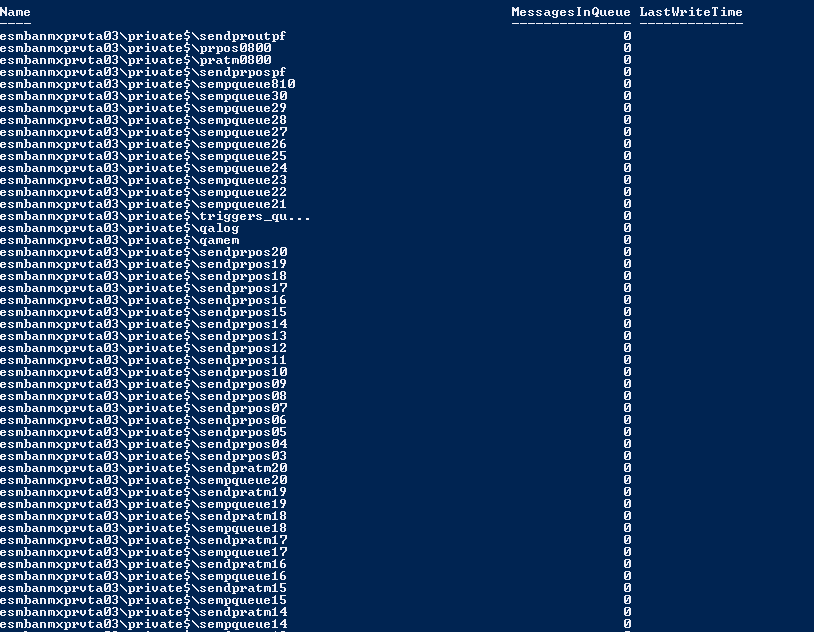Количество сообщений в MSMQ через Powershell
Я хотел бы предоставить queuepath и получить количество сообщений после этого. Есть советы, как это сделать?
10 ответов
это будет список всех очередей на машине и количество сообщений:
gwmi -class Win32_PerfRawData_MSMQ_MSMQQueue -computerName $computerName |
ft -prop Name, MessagesInQueue
Итак, я увидел это: что я могу сделать с C# и Powershell? и пошел here:http://jopinblog.wordpress.com/2008/03/12/counting-messages-in-an-msmq-messagequeue-from-c/
и сделал это
# Add the .NET assembly MSMQ to the environment.
[Reflection.Assembly]::LoadWithPartialName("System.Messaging")
# Create a new QueueSizer .NET class help to warp MSMQ calls.
$qsource = @"
public class QueueSizer
{
public static System.Messaging.Message PeekWithoutTimeout(System.Messaging.MessageQueue q, System.Messaging.Cursor cursor, System.Messaging.PeekAction action)
{
System.Messaging.Message ret = null;
try
{
// Peek at the queue, but timeout in one clock tick.
ret = q.Peek(new System.TimeSpan(1), cursor, action);
}
catch (System.Messaging.MessageQueueException mqe)
{
// Trap MSMQ exceptions but only ones relating to timeout. Bubble up any other MSMQ exceptions.
if (!mqe.Message.ToLower().Contains("timeout"))
{
throw;
}
}
return ret;
}
// Main message counting method.
public static int GetMessageCount(string queuepath)
{
// Get a specific MSMQ queue by name.
System.Messaging.MessageQueue q = new System.Messaging.MessageQueue(queuepath);
int count = 0;
// Create a cursor to store the current position in the queue.
System.Messaging.Cursor cursor = q.CreateCursor();
// Have quick peak at the queue.
System.Messaging.Message m = PeekWithoutTimeout(q, cursor, System.Messaging.PeekAction.Current);
if (m != null)
{
count = 1;
// Keep on iterating through the queue and keep count of the number of messages that are found.
while ((m = PeekWithoutTimeout(q, cursor, System.Messaging.PeekAction.Next)) != null)
{
count++;
}
}
// Return the tally.
return count;
}
}
"@
# Add the new QueueSizer class helper to the environment.
Add-Type -TypeDefinition $qsource -ReferencedAssemblies C:\Windows\assembly\GAC_MSIL\System.Messaging.0.0.0__b03f5f7f11d50a3a\System.Messaging.dll
# Call the helper and get the message count.
[QueueSizer]::GetMessageCount('mymachine\private$\myqueue');
и это сработало.
решение, предоставленное Ирвином, меньше, чем идея.
есть .GetAllMessages вызов вы можете сделать, чтобы это было сделано за одну проверку, а не за цикл foreach.
$QueueName = "MycomputerName\MyQueueName"
$QueuesFromDotNet = new-object System.Messaging.MessageQueue $QueueName
If($QueuesFromDotNet.GetAllMessages().Length -gt $Curr)
{
//Do Something
}
на .Length дает вам количество сообщений в очереди.
PowerShell под Windows Server 2012/2012 R2 и Windows 8/8.1 имеет кучу встроенных командлетов, которые можно использовать, установив Microsoft message Queue (MSMQ) Server Core характеристика.
# Get all message queues
Get-MsmqQueue;
# Get all the private message queues.
# Display only the QueueName and MessageCount for each queue.
Get-MsmqQueue -QueueType Private | Format-Table -Property QueueName,MessageCount;
существует ряд других командлетов, которые можно использовать для управления очередями и создания сообщений. т. е.
- New-MsmqQueue
- Удалить-MsmqQueue
- Отправить-MsmqQueue
- Receive-MsmqQueue
- Get-MsmqQueueManager
полный список командлетов MSMQ см. В разделекомандлеты MSMQ в Windows PowerShell или Get-Command -Module MSMQ если у вас уже установлена функция.
после presciptions от этой ссылке, вы можете использовать
$queues = Get-WmiObject Win32_PerfFormattedData_msmq_MSMQQueue
$queues | ft -property Name,MessagesInQueue
чтобы получить размер локальных очередей или
$host = ...
$cred = get-credential
$queues = Get-WmiObject Win32_PerfFormattedData_msmq_MSMQQueue -computer $host -credential $cred
$queues | ft -property Name,MessagesInQueue
для удаленной очереди.
существует набор командлетов управления MSMQ в Расширения Сообщества PowerShell. Попробуйте и посмотрите, поможет ли кто-нибудь из них (возможно, Get-MSMQueue):
Clear-MSMQueue
Get-MSMQueue
New-MSMQueue
Receive-MSMQueue
Send-MSMQueue
Test-MSMQueue
Примечание: попробуйте захватить модуль бета 2.0 на основе distrubtion-просто не забудьте "разблокировать" zip, прежде чем распаковать его.
попробуйте один из этих...
function GetMessageCount2($queuename)
{
$queuename = $env:computername + "\" + $queuename
return (Get-WmiObject Win32_PerfFormattedData_msmq_MSMQQueue | Where-Object -filterscript {$_.Name -eq $queuename}).MessagesinQueue
}
function GetMessageCount3($queuename)
{
return (Get-MsmqQueue | Where-Object -FilterScript {$_.QueueName -eq $queuename}).MessageCount
}
Я искал хороший ответ на это, и в то время как ответ Ирвина поставил меня на правильную основу, я искал какой-то код, который был немного больше Powershell-ish. Основная причина этого-иметь дело с изменениями, так как вы не можете Add-Type несколько раз из-за типа, загружаемого во время выполнения .Net, и не может быть выгружен без закрытия экземпляра powershell.
поэтому я взял его ответ и придумал:
# Add the .NET assembly MSMQ to the environment.
[Reflection.Assembly]::LoadWithPartialName("System.Messaging") | out-Null
function Get-QueueNames([Parameter(Mandatory=$true)][String]$machineName, [String]$servicePrefix)
{
[System.Messaging.MessageQueue]::GetPrivateQueuesByMachine($machineName) |
ForEach-Object { $_.Path } |
Where-Object { $_ -like "*$($servicePrefix).*" }
}
function Get-MessageCount([parameter(Mandatory=$true)][String]$queueName)
{
function HasMessage
{
param
(
[System.Messaging.MessageQueue]$queue,
[System.Messaging.Cursor]$cursor,
[System.Messaging.PeekAction]$action
)
$hasMessage = $false
try
{
$timeout = New-Object System.TimeSpan -ArgumentList 1
$message = $queue.Peek($timeout, $cursor, $action)
if ($message -ne $null)
{
$hasMessage = $true
}
}
catch [System.Messaging.MessageQueueException]
{
# Only trap timeout related exceptions
if ($_.Exception.Message -notmatch "timeout")
{
throw
}
}
$hasMessage
}
$count = 0
$queue = New-Object System.Messaging.MessageQueue -ArgumentList $queueName
$cursor = $queue.CreateCursor()
$action = [System.Messaging.PeekAction]::Current
$hasMessage = HasMessage $queue $cursor $action
while ($hasMessage)
{
$count++
$action = [System.Messaging.PeekAction]::Next
$hasMessage = HasMessage $queue $cursor $action
}
$count
}
$machineName = "."
$prefix = "something"
Get-QueueNames $machineName $prefix |
ForEach-Object {
New-Object PSObject -Property @{
QueueName = $_
MessageCount = Get-MessageCount $_
}
}
его можно оптимизировать так, что первая функция возвращает очереди вместо имен очередей, но мне нужны оба для разных сценариев.
winrm s winrm/config/client '@{TrustedHosts="yourIp"}'
$securePassword = ConvertTo-SecureString "YourPassword" -AsPlainText -force
$credential = New-Object System.Management.Automation.PsCredential("Domain\Usernama",$securePassword)
$session = New-PSSession YourIP -credential $credential
$command = {Get-WmiObject Win32_PerfFormattedData_msmq_MSMQQueue | ft -property Name,MessagesinJournalQueue,MessagesInQueue | out-String}
Invoke-Command -session $session -scriptblock $command
используйте это для вашего блока C#, чтобы получить счетчик. Он использует счетчик производительности для запроса один раз:
public static int GetMessageCount(string machineName, string queuepath)
{
var queueCounter = new PerformanceCounter(
"MSMQ Queue",
"Messages in Queue",
string.Format("{0}\{1}", machineName, queuepath),
machineName);
return (int)queueCounter.NextValue();
}
Это более эффективно, чем повторяющийся взгляд, поскольку работа в основном выполняется на удаленной машине, также более эффективна, чем GetAllMessages, поскольку это возвращает дополнительные данные сообщений, а затем подсчитывает элементы - ужасная производительность при любой реальной нагрузке.

